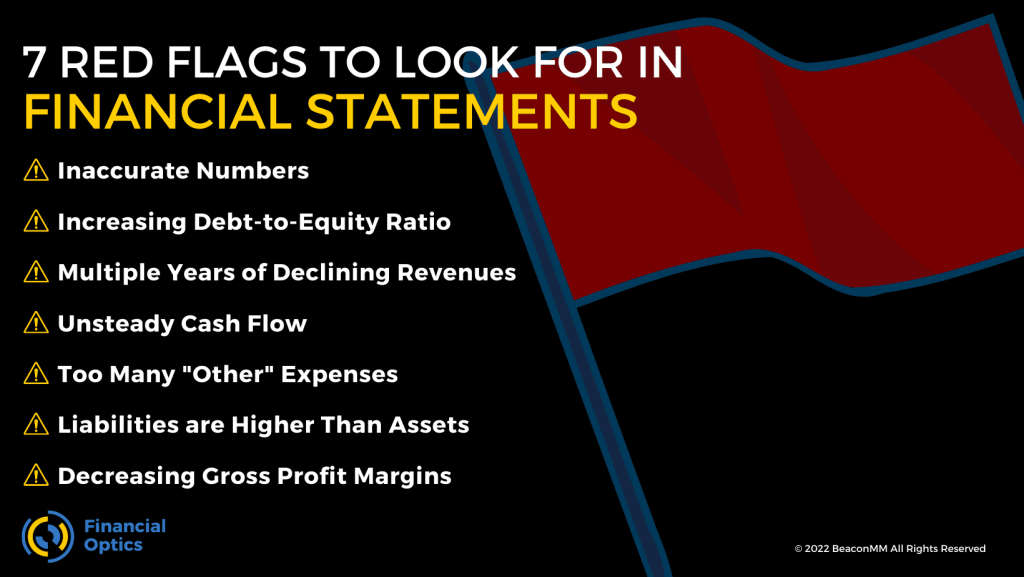Are you feeling uncertain about your business’s financial statements? Commonly, small to mid-sized businesses are often not financially able to hire a high-level, full-time CFO or controller for their company – let alone a financial and accounting team. In situations such as this, it can be challenging to manage all of the details related to record keeping, taxes, billing, financial statements, and reports. Without a financial expert on your side, you may have concerns arise every day regarding properly evaluating business performance, conducting proper historical data analysis, and overcoming red flags in your financial statements. Red flags pop up regularly when you don’t have the right systems in place for growth and scalability. Without a full accounting and financial support system, it’s difficult to manage business finances when you aren’t sure what to look for. Here are the top red flags to look for in financial statements that need to be adequately addressed in order to grow your business and capture a competitive marketplace advantage, bottom-line profitability, and success. Are you ready to eliminate red flags in your financial statements? Contact Financial Optics today to learn how financial insight can take your business to the next level!
What It Means to Find Red flags in Your Financial Statements
Financial statements with red flags can take away from your valuable time and energy. Rather, you’ll pour endless hours into deciphering your financial statements and trying to determine what’s amiss. How can you avoid this to begin with? By seeking support to strengthen your processes, increase profitability, and free up your time to focus on managing the various aspects of your business. Unfortunately, financial statement red flags can signal potentially deeper financial issues, such as fraudulent practices, accounting anomalies, and unstable sales numbers. You may even find yourself in a situation where your business is losing money and you’re struggling to stay afloat.
Breaking Down the Parts of Your Financial Statement
A company’s financials offer the most reliable way to assess the overall health of a business. And when numbers appear off-balance or indicate sales are not what you think they should be, your data may be telling you something. Your financial statements may have some red flags that need to be addressed. But before you can identify the issues, there are several aspects of a financial statement that need to be evaluated and understood. To help you to recognize these red flags and address them, let’s first break down the parts of your financials:
- Financial Statement: A financial statement is a collection of reports that offer an organization an overview of the company’s cash flows and financial condition. Reports include:
- A balance sheet
- An income statement
- A statement of cash flows
- Financial Statement Notes: These are notes regarding the company’s accounting practices and principles to assist in the reading of the documentation.
- An Auditor’s Report: The auditor’s report is prepared by financial statement auditors to outline high-level business trends and opinions based on the data and critical findings.
- An Executive Summary or Management Discussion and Analysis: This is a statement or summary from management regarding essential details that company leaders wish to communicate about the business. This could be a statement read by investors, management, or other essential stakeholders.
Each of these financial statement sections offers critical and valuable information to enable a company to determine profitability, cash flow, liquidity, and important data for evaluating the overall organizational health of a company.
7 Common Red Flags in Your Financial Statements

- Inaccurate numbers. If you don’t have an accountant, CFO, or controller, you may be trying to manage your financial statements without proper support. When accounting doesn’t accurately portray your profitability, cash flow, and growth, you may need to outsource accounting to professionals.
- Increasing debt-to-equity. This ratio indicates that your business may be experiencing more debt than you can handle. If a debt-to-equity ratio is over 100%, that’s a definite red flag to consider
- Multiple years of declining revenues. When a business experiences multiple years of trending down revenues, there’s a red flag that needs to be immediately addressed by a professional.
- Unsteady cash flow. When you have a steady cash flow, that’s a good sign of organizational health. But when there’s an unsteady cash flow, eyebrows should raise. This situation should be carefully evaluated and addressed.
- Additional expenses on your balance sheet identified as “Other.” When there are multiple expenses labeled as “other” on your financial statement, this is a red flag to look for. Expenses need to be consistent and organized under proper categories. If the expenses referred to as “other” are larger than they should be, it needs to be addressed and resolved on your financial statement.
- Liabilities are higher than assets. When liabilities outweigh assets, organizational performance, cycles, and seasons should be considered. But if a business continually assumes more liability without an increase in assets, this could serve as a red flag.
- Decreasing gross profit margins. Gross profit margins are measured by a business’ ratio of profits earned as compared to costs over time. A declining gross profit margin may serve as an alarm that something in your financial statement is off-balance.
These are just some examples of red flags in your financial statements. Each of these areas can significantly impact your company’s bottom-line revenues and profitability. If you don’t have the financial or accounting resources to address these red flags, rather than continue to be on the default and lose money, consider turning to an outsourced accountant to gain valuable support and insight. Utilizing an accountant, Virtual CFO, or controller from a professional financial firm can provide the expertise you need to properly analyze the red flags you may be experiencing in your business.
Addressing Financial Statement Concerns to Ensure Success
You can address and eliminate red flags in your financial statements by seeking support from Financial Optics. We can address these red flags and put your company on course for a successful future while assessing your business’s profitability. So, if you’re feeling uncertain about the red flags you may see in your financial statement, we can help! Financial Optics provides essential support to strengthen your statement processes, increase profitability, and free your staff’s time to focus on other aspects of the business. We provide outsourced bookkeeping, outsourced accounting, and virtual CFO/business advising services on a national level. With over 30 years of experience, we can help you eliminate the stress and red flags in your financial statements and processes. Are you ready to eliminate red flags in your financial statements? Schedule a free consultation with Financial Optics today to learn how we can help your business thrive!

